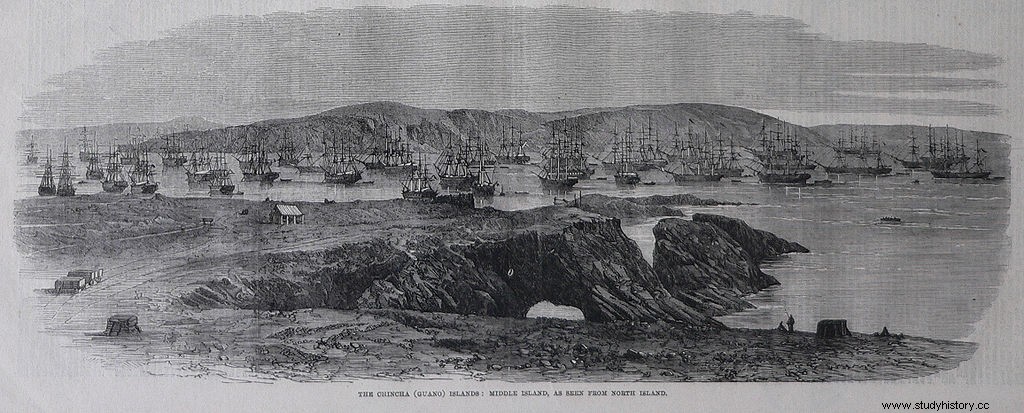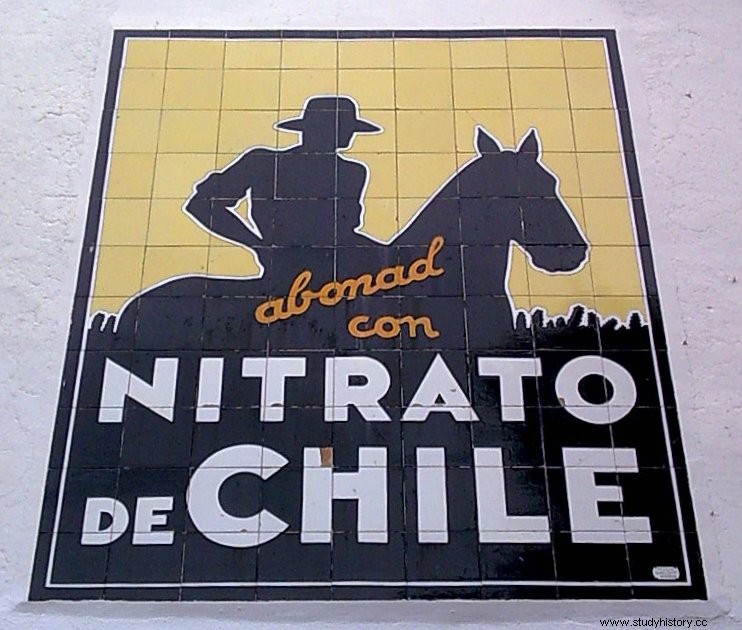Mid-late 19th century. The European population was facing, perhaps for the first time, the forebodings of Malthus's theory which said that food production would not increase in the same proportion as the population, which meant that, in fact, there would be in the short term term serious supply problems of basic products. The fields of the Old World were depleted after decades of overharvesting and erosion. It was the British, starting in the 1840s, who discovered the magnificent fertilizing properties of Guano and at that time began the large-scale exploitation of such precious fertilizer from Peru:
The gannets and the seagulls, fed by the fabulous schools of the currents that lap the shores, had been accumulating on the islands and islets, since time immemorial, great mountains of excrement rich in nitrogen, ammonia, phosphates and alkaline salts.

Chincha (Peru) – The guano islands
A decade later, agricultural chemistry came to discover that the benefits of Salitre were even greater. and its use in Europe as a fertilizer became popular, coming, in the form of soda nitrate, from the Peruvian and Bolivian saltpeter fields:Tarapaca and Antofagasta , respectively:
Thanks to the saltpeter and guano, which lay on the Pacific coast almost within reach of the ships that came to look for them, the ghost of hunger moved away from Europe.
Until then, the Lima oligarchy had prospered thanks to the Silver from Potosí (it sounds like the expression "this is worth a potosí"); From this moment they began to flourish thanks to bird droppings and the "bright white lump of saltpeter." And there were the British, replacing the Spanish, to take over the business:the credits that the state requested -as a consequence of the wasteful waste in which it had settled-, mortgaging its future, were in English hands. In 1868 the issue definitely worsened when the expenses and debts of the state far exceeded the income generated by exports (what does this situation sound like to you too?). To finish the mess, the guano deposits were used as a guarantee of payment, which in fact generated the loss of sovereignty over natural resources. Meanwhile, the workers suffered labor and living conditions bordering on slavery.
According to Eduardo Galeano account in The open veins of Latin America , published in 1971 and subsequently reissued on numerous occasions, "the exploitation of saltpeter quickly spread to the Bolivian province of Antofagasta, although the business was not Bolivian, but rather Peruvian and, above all, Chilean." The Bolivian government tried to apply a tax to the exploiters and exporters of saltpeter located in its territory and it was then that the Chilean army invaded the province and never left there. Perhaps you know that Bolivia is the only country in the Americas (along with the neglected Paraguay) that does not have access to the sea. Before 1879, start date of the Guano and Saltpeter War , also called the Pacific War, this was not so. In that conflict, Chile annexed a series of coastal territories and since then Bolivia has been periodically claiming what was its own or, at least, a corridor that gives it a natural outlet to the sea. As you might guess, Chile and Peru don't even want to hear about it.

Guano and Saltpetre War
Peru and Bolivia suffered from then on a bloodletting whose consequences they still suffer, in part due to the loss of their main natural resources. But what happened to the winners of that conflict, the Chileans?
At the beginning of the conflict, Chile's income depended on 5% of saltpeter and iodine. A decade later the figure amounted to more than half, mainly coming from the exploitation of the resources they obtained from the recently conquered territories. And, as you may have suspected, English investments in the region tripled to the point of turning the saltpeter region into "a British factory." While Chileans, Bolivians and Peruvians fought among themselves, the British took over this prosperous industry without having disbursed a penny, since the financing was gladly provided by the Chilean banks themselves.

In 1890, Chile already destined three quarters of its exports to England and received from it half of its imports, even greater commercial dependence than with colonial India. With this apparent prosperity, President Balmaceda he faced an ambitious plan of progress for the country:industrial development, public works, education... and, aware of his dependence on England, he closed the tap on British territorial expansion in the country. In 1891 the civil war broke out (yes, friends; Chile also had its civil war) and you can imagine which side the British supported and who was defeated. As the British ambassador informed the city:
It is no secret that the British community is satisfied with the fall of Balmaceda, whose victory would have involved serious damage to British commercial interests.
So British companies secured and expanded their domains, while the reform plans of the ousted government fell apart. And the prosperity of the saltpeter exploitations did not serve for local development, but to increase the inequalities and structural deformations of its economy.
And this is where the chemists Fritz Haber enter the scene. and Carl Bosch , Prussian and German, respectively. They were responsible for the development, patent and commercialization of the Haber-Bosch process , which basically consists of obtaining nitrogen from the air and producing ammonia at an industrial level which, when oxidized, forms nitrites and nitrates, essential in the production of fertilizers. This process currently has no jurisdiction in this area. Both received the Nobel Prize in Chemistry, Haber in 1918 and Bosch in 1931. The obvious consequence was the progressive but inexorable collapse of the Chilean economy in the following decades, excessively dependent on the saltpeter trade, which ceased to be a fundamental raw material at the international level. worldwide in the production of manure and fertilizers.
This is how chemistry ended up defeating the victors of that other Pacific War.
Collaboration Rafael Ballesteros of IMBALANCES
